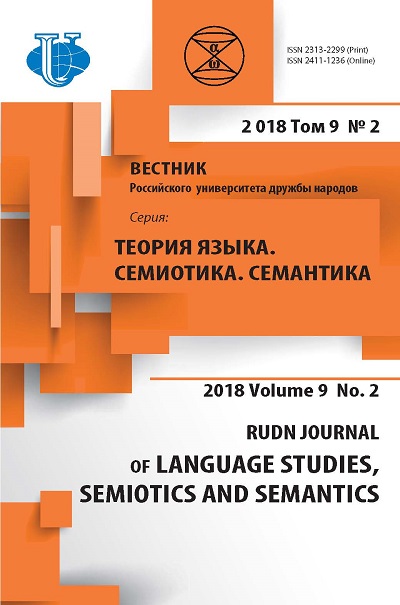ALGORITHM OF ANALYSIS the BUSINESS LETTER
- Authors: Pudikova G.N.1
-
Affiliations:
- RUDN University
- Issue: Vol 9, No 2 (2018)
- Pages: 480-496
- Section: SCIENCE 21.0
- URL: https://journals.rudn.ru/semiotics-semantics/article/view/18757
- DOI: https://doi.org/10.22363/2313-2299-2018-9-2-480-496
Cite item
Full Text
Abstract
The algorithm of analysis of business letter in Russian, English and Portuguese languages on the basis of next aspects: style and genre, structure-semantic and pragmatic features, pragmatic information, genre varieties are presented in the article. A business letter as the type of text that has the special communicative structure and provided with documentary force grammatically executed and semantically completed is certained here. It is shown that pragmatic information in texts of business letter will be realized through the grammatical category of modality and pragmatic category of business politeness, that explisite in hyperbolae, formulas of politeness and indirect speech act of request. A commitment letter as the form of business correspondence is examined. A commitment letter is presented as a document, in that a sender promises or guarantees to carry out implementation of some actions in regard to an addressee, that conected with its interests. The aim of the article: to investigate the specific of analysis of business letters in Russian, English and Portuguese.
Keywords
About the authors
Galina Nikolaevna Pudikova
RUDN University
Author for correspondence.
Email: pudikova.g.n@gmail.com
Assistant of the Russian Language Department No. 1 of Faculty of Russian language and General Educational Disciplines of RUDN University; Scientific interests: theory, practice and methodology of teaching Russian as a foreign language, comparativistics
6, Miklukho-Maklaya str., Moscow, Russia, 117198References
- Belova, A.D. (2003). Linguistic aspects of argumentation. 2 ed. Moscow: Logos. (In Russ.).
- Blumer, G. (2001). Social problems as collective behavior. In: Ed. I. Yasaveev. Contexts of modernity II: Topical problems of society and culture in Western social theory: a reader. The General editorship of S.A. Yerofeyev; 2 ed., EXT. and pererab Kazan: publishing house of KAZ. UN-TA, (TEMPUS program (TACIS)), 150—151.
- Bondarko, A.V. (1996). The Problems of grammatical semantics of the Russian Aspectology. SPb.: Publishing house in Pb With the U. (In Russ.).
- Vostrikova, N. (2004). In. Functionally stylistic features of the French commercial letter [dissertation]. Pyatigorsk. (In Russ.).
- Gerasimenko, I.V. (2001). Sociopragmatics of American business correspondence (diachronic aspect) [dissertation]. Khabarovsk. (In Russ.).
- Dibrova, E.I. (1996). Communicative cognitive model of text production. Dokl. V international. Conf. “Semantics of linguistic units”. Moscow. 130—137. (In Russ.).
- Drabkina, I.V. (2001). Pragmalinguistic aspects of written business communication: on the material of English-language texts of contracts and business correspondence [dissertation]. (In Russ.).
- Elkin, V.V. (2001). Dialogue speech the main sphere of realization of language economy [dissertation]. Pyatigorsk. (In Russ.).
- Jespersen, O. (1958). The Philosophy of grammar: TRANS. from English. M.: publishing house of the foreign literature. (In Russ.).
- Zaretskaya, E.N. (2012). Business communication. In 2's T. M.: Delo publ. Vol. 1. (In Russ.).
- Yokoyama, O.B. (2005). Cognitive discourse model and Russian word order. M.: languages of Slavic culture.
- Kalyuzhnaya, V.V. (1982). Style of English-language documents of international organizations. Moscow: Science. (In Russ.).
- Karasik, V.I. (2004). Language circle: personality, concepts, discourse. Moscow: Gnosis. (In Russ.).
- Kozhina, M.N. (1998). To bases of functional stylistics. Perm: PTU. (In Russ.).
- Komarova, Rn (2000). Language of the law, linguistic characteristics. On the material of the text of the German civil code [dissertation]. SPb. (In Russ.).
- Cottier, G.A. (2009). Business letter in English: Sample translation in Russian language: prakt. manual. In.: G.A. Cottier, V.R. Gulmiradov. Moscow: Ed. in the 1st Federal Bookseller Company. (In Russ.).
- Manera, L.A. (2002). Foundations of the conceptual integration of mental spaces. Text and discourse: traditional and cognitive-functional aspects of the study. Ryazan: Publishing house in Ryaz. GOS. PED. UN-TA. 17—29.
- Punicic, V. (2010). Business letter: prakt. a manual In. V.V. Panicek. Minsk: Amalfeya.
- Repina, T.A. (2016). Comparative typology of Romanesque languages (French, Italian, Spanish, Portuguese, Romanian). St. Petersburg. (In Russ.).
- Wilkie, Helen. (2014). Basics of business communication: write, speak, listen: Per. English. H. Wilkie. M.: Basics of the business unit. “Nirro”. (In Russ.).
- Fedurko, S.Y. (2002). Stylistic peculiarities of the Russian business letters as genre variety is officially business style [dissertation].Voronezh. (In Russ.).
- Franklin, V. (2006). Selected works. Moscow: Science.
- Fromm, E. (2012). Man for himself: Per. English. Moscow: Collegium. (In Russ.).
- Shmelyova, T.V. (2015). The Semantic syntax. Krasnoyarsk: Krasnoyarsk. state University, MT, 1994.Czinkota, Michael R. International business. Michael R. Czinkota, Ilkka A. Ronkainen, Michael H. Moffett. 7th ed. Australia [etc.]: Thomson, South Western,. XXXIII. (In Russ.).
- Gunnarsson, B.L. (2000). Message Structure in LSP Texts. A Socially Determined Variation at Different Text Levels, Proc. NORDTEXT symp. Espoo (Finnland). 91—107.
- Lehmann, Ch. (1998). Towards a Typology of Clause Linkage. Clause combining in grammar and discourse, 18, 188—227.
- Millrood, R. (2002). English Discourse and Culture: Diversity and Globalisation.Vestnik MGU. Ser. 19.: Linguistics and intercultural communication, (3), 60—73.
- Traugott, E.C. (1996). Complex sentences. The Cambridge History of the English Language. Ed. by R.M. Hogg. Cambridge: CUP, 219—290.
- Willums, Jan Olaf. (2012). From ideas to action. Business and sustainable development: the ICC rep. on the greening of enterprise 92 / Jan Olaf Willums, Ulrich Gol.













